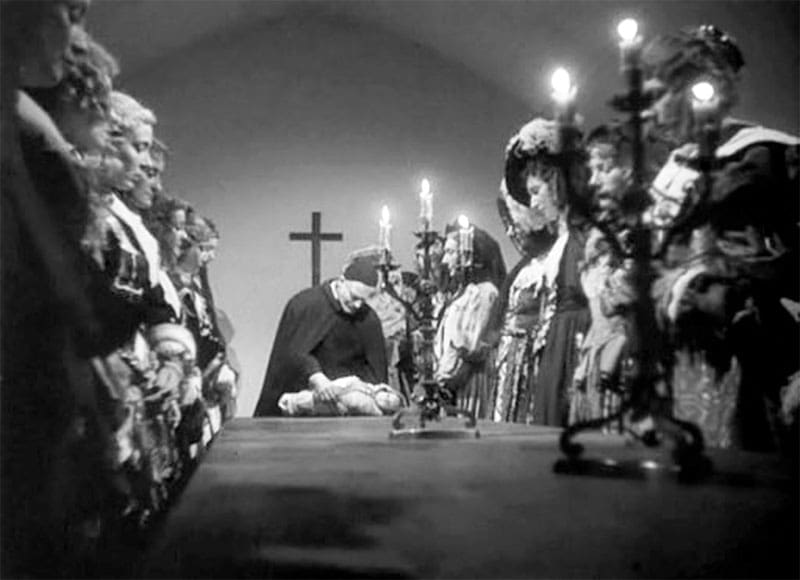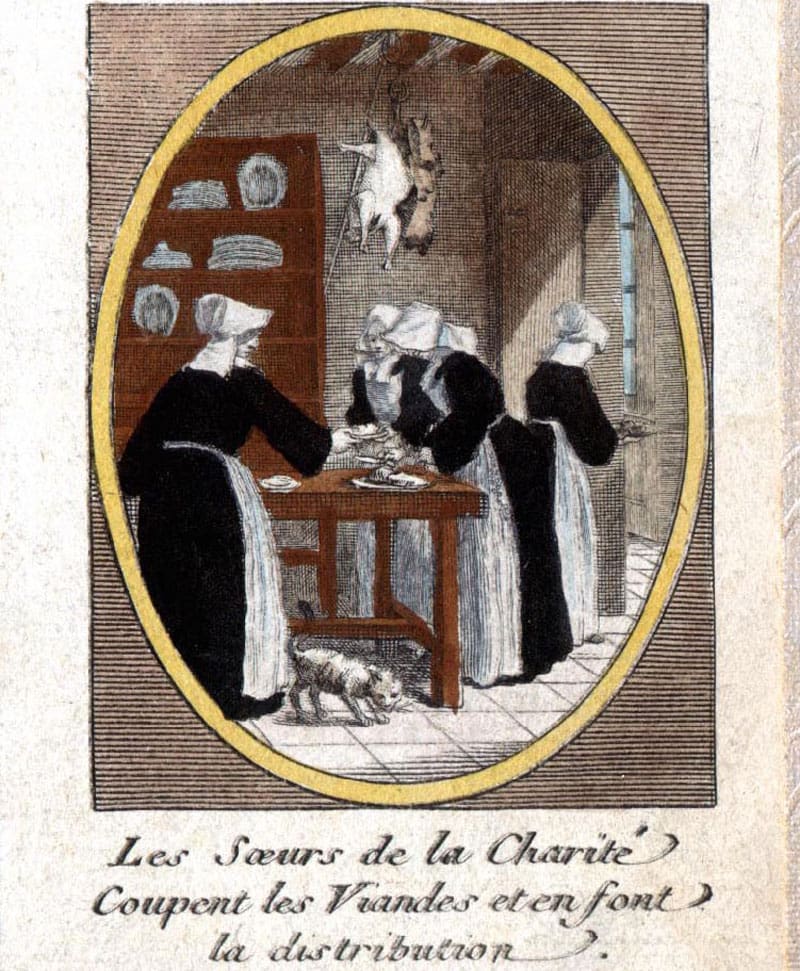You may not believe that one man could do all that Vincent did!
Just read these highlights from Fr. Robert Maloney, C.M.’s Welcoming the Stranger St. Vincent de Paul and the Homeless.
Foundling children – The “13 houses”
Queen Anne of Austria assigned a million dollars to Vincent as a stable endowment for his Congregation’s missions in Sedan. Notice how he leveraged this money.
Vincent chose to use the money to build 13 small houses close to Saint-Lazare, the motherhouse of the Congregation of the Mission. He then rented them to the Ladies of Charity to use for lodging the foundlings.
But the number of foundlings continued to grow and funds to provide for them were difficult to find. In 1647, the Ladies of Charity considered abandoning the work. Vincent saved it by making a well-known impassioned appeal to them, calling the foundlings their children:

Vincent brings in a foundling at a meeting of the Ladies of Charity. (From the film Monsieur Vincent)
Eventually, Vincent assigned numerous Daughters of Charity to care for the foundlings. Describing the sisters’ vocation, he wrote,
“They will reflect that their ministry is to serve the Infant Jesus in the person of each baby they are raising, and in this they have the honor of doing what the Blessed Virgin did to her dear Son, since He affirms that the service rendered to the least of His people is rendered to Himself.
Note his genius for collaboration!
Housing for refugees and people fleeing war
Reflecting on Vincent’s accomplishments in Lorraine, the historian Bernard Pujo concluded:
This support for Lorraine is remarkable for more than the amount of aid distributed and the number of suffering people helped. It was the first attempt at organized assistance for a whole endangered region. Without having received any specific charge, Vincent de Paul assumed the role of a secretary of state for refugees and war victims. Going far beyond the responsibilities expected of him as superior of the Congregation of the Mission, he placed himself, on his own initiative, in a national role.
Beginning in 1639, Vincent succeeded in supplying Lorraine with help amounting to more than 60 million dollars and more than 38,000 yards of various fabrics. He raised funds initially from the Ladies of Charity and eventually obtained contributions from the highest authorities. King Louis XIII made a gift of $1,800,000.
Notice that trust in him… people of wealth trusted him with aid!

Vincent de Paul with Ladies of Charity, one removing jewelry to donate; foundlings; Daughters of Charity; original in Ghizeghem; courtesy of C. Lautissier
Shelter, clothing, and food for those living on the streets of Paris
Vincent wrote to one of his priests, describing the situation,
“We have more troubles here than ever. Paris is swarming with poor persons because the armies have forced the poor country folk to seek refuge here. Meetings are held daily to see how they can be helped. A few houses have been rented in the outlying districts where some of them have been housed, particularly poor girls.”
The “Name of Jesus Hospice” – Vincent, at the age of 72, was running massive relief programs, providing soup twice a day for thousands of poor people at Saint-Lazare and feeding thousands of others at the houses of the Daughters of Charity. He organized collections, gathering each week 5-6 thousand pounds of meat, 2-3 thousand eggs, and provisions of clothing and utensils. He provided lodging for the displaced.
Notice how they addressed immediate needs!

Daughters of Charity preparing meat for distribution
Job training and faith formation for those living in desperate circumstances
The “Little Schools” – Though the terminology “systemic change” was unknown to Vincent and Louise, they both recognized, on a seminal level, that education and job training were extremely important in transforming the lives of the homeless and the poor.
Vincent and Louise de Marillac were deeply committed to the education and moral formation of young people living on the streets or in dire conditions. They wanted them to develop the skills needed to get jobs. For that reason, with Vincent’s support, Louise founded the “petites écoles” (little schools) and made the instruction of poor young people one of the principal works of the first Daughters of Charity.

Remember these are only “highlights.” Truly an amazing record of direct aid and long term solutions!
Leaders of the Vincentian Family walk in his footsteps.





0 Comments